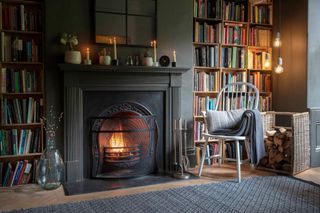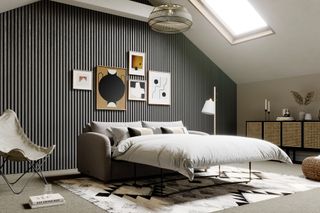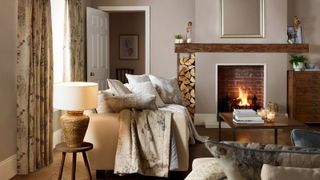What is ambient temperature — and how warm should your home be this winter?
Achieving the perfect ambient temperature in your home isn't as simple as cranking up the heating – it requires a careful balance of effective heating systems and regular maintenance

As the weather gets colder, thoughts inevitably turn to keeping our homes cosy over winter. But staying warm isn't just a case of cranking the heating up – it’s about creating a stable and comfortable environment that enhances the well-being of everyone in the household and the fabric of the house itself.
When we talk about the 'ambient temperature' of our homes, we're referring to the overall feel of warmth or coolness in our living spaces. The key to achieving the perfect ambient temperature throughout our homes is to maintain a consistent and comfortable level of warmth, no matter how cold it is outside.
In our handy guide, we'll take a look at the recommended ambient temperature for the average UK home, and examine some of the consequences to keeping your house too hot or too cold.
What is the ideal home temperature?
Guidelines from the Energy Saving Trust suggest that during winter your home should be kept between 18 to 21°C. This range strikes a good balance between comfort and energy efficiency.
Hayley Janssen, Public Health Researcher at Public Health Wales, states: "[The] Welsh Government currently advise households to set temperatures to 21°C in the living room and 18°C in other rooms for 9 hours in every 24-hour period on weekdays, and 16 hours in a 24-hour period on weekends".
Of course, these recommendations are merely guidelines, and families with young children, elderly people, or chronically unwell occupants should seek personalised recommendations to ensure that your household's ambient temperature is suited to their needs.
What are the risks of having a cold home?

No one wants a cold home. Aside from the obvious fact that colder homes are less comfortable, keeping your ambient temperature below 15°C for prolonged periods of time can have a negative impact on the fabric of your home. Potential consequences of chilly homes include:
Condensation: When warm, moist air encounters colder surfaces, such as windows or walls, the air cools down and can't hold as much moisture. This excess moisture is released and forms condensation. In colder homes, many surfaces are at a lower temperature, making them prime spots for condensation.
Damp and Mould: Colder homes also tend to have inadequate ventilation, either due to efforts to keep heat in or because of older, less efficient building designs. When warm, moist air from activities like cooking, showering, or drying clothes indoors is trapped, it increases humidity levels, leading to problems with damp and/or mould.
These issues not only damage your home's structure but they can also pose health risks, particularly in regards to respiratory troubles. Moreover, cold environments can worsen certain health conditions, leading to discomfort or illness.
What are the risks of keeping your home too hot?

Conversely, an overheated home is not advisable either. Keeping a house excessively hot can have several drawbacks, both for the inhabitants and the house itself:
Increased energy costs: One of the most immediate impacts of overheating your home is the increase in energy bills. Maintaining a high temperature requires more energy, whether you're using central heating, electric heaters, oil filled radiators, or any other heating system. This can lead to significantly higher utility bills, especially in the colder months.
Sleep disruption: A hot environment can severely disrupt sleep patterns. The body naturally cools down during sleep, and a room that's too warm can make it difficult to get a proper night’s rest.
Air quality: High temperatures can worsen indoor air quality. It can increase the off-gassing of volatile organic compounds (VOCs) from furniture and building materials and can also heighten humidity levels in your home. In some circumstances, a humidifier may be required to offset the dry air caused by overheating.
A strain on heating systems: Maintaining a consistently high temperatures can put undue strain on your heating systems, potentially leading to more frequent repairs and a shorter lifespan for your boiler or radiators.
How to maintain the ideal ambient temperature
It's important to maintain a comfortable – but not excessive – ambient temperature in your home over winter. To achieve this careful balance, we suggest the following:
1. Invest in effective home insulation

To minimise heat loss and keep warmth inside your home, it’s important to ensure your house is well-insulated. Double-glazed and well insulated windows will help retain your homes heat; though secondary glazing may be a useful solution for listed buildings or property's where double-glazing is not an option.
"Insulating walls, either internally, externally or in a cavity wall, is an important part of achieving a thermally efficient home," says Tim Pullen, energy efficiency expert. "Not only are well insulated homes better for the environment but a home where heat loss is kept to a minimum means lower energy bills and increased long-term savings".
Similarly, if your house has an attic or loft space, loft insulation can significantly reduce heat loss. How much loft insulation you will need to keep your home warm over winter will largely depend on the kind of space you are dealing with and what you intend to use it for.
2. Service and maintain your heating systems

Keep your heating systems in top condition by regularly servicing them for efficient operation. Learn how to bleed a radiator, to release the air and get your heating system running more efficiently. You may also want to power flush your radiators to reduce the chances of cold spots.
Taking good care of your boiler truly pays off, not only in potential savings on your energy bills but also in guaranteeing that your heating system operates at maximum efficiency whenever you use it. It’s a good idea to get your boiler serviced before the dead of winter, as you don't want it to cut out in the midst of a cold spell.
3. Install programmable heating controls

According to Tim Pullen, there are serious question marks over whether combi-boilers are a good way to maintain the recommended ambient temperature, as they offer the bare minimum level of control. Instead, he recommends utilising programmable thermostats to set a consistent temperature throughout your home or to reduce heating when it's unnecessary.
"With today's smart technology, it's possible to download a phone app to control the temperature or timing of your heating and/or hot water system from wherever you are", says Tim. Price wise, these systems and related apps typically cost between £200 and £250 (though some prices include installation and some don’t).
The tips above will help you maintain a desirable ambient temperature in your home. Should you be embarking on a new build or a house renovation, you may also want to look into modern heating systems, like underfloor heating and air source heat pumps. Underfloor heating offers a consistent and even distribution of warmth throughout your home, while air-source heat pumps are known for their energy efficiency and ability to provide effective heating and cooling.
Get the Homebuilding & Renovating Newsletter
Bring your dream home to life with expert advice, how to guides and design inspiration. Sign up for our newsletter and get two free tickets to a Homebuilding & Renovating Show near you.

Gabriella is an interiors journalist and has a wealth of experience creating interiors and renovation content. She was Homebuilding & Renovating's former Assistant Editor as well as the former Head of Solved at sister brand Homes & Gardens, where she wrote and edited content addressing key renovation, DIY and interior questions.
She’s spent the past decade crafting copy for interiors publications, award-winning architects, and leading UK homeware brands. She also served as the Content Manager for the ethical homeware brand Nkuku.
Gabriella is a DIY enthusiast and a lover of all things interior design. She has a particular passion for historic buildings and listed properties, and she is currently in the process of renovating a Grade II-listed Victorian coach house in the West Country.